
The production of calcium cored wire is a meticulous process that involves several stages, from the selection and preparation of raw materials to the manufacturing and packaging of the final product. This article provides an overview of the calcium cored wire production process flow, highlighting the essential steps involved in creating this vital component for steelmaking.
The first step in the production process is the careful selection and preparation of raw materials. High-quality calcium alloy is chosen, considering factors such as purity, composition, and grain size. The raw materials are thoroughly inspected, and any impurities or unwanted elements are removed through various refining techniques.
Once the raw materials are prepared, the next stage involves melting the calcium alloy. The alloy is melted in a controlled environment, such as an electric arc furnace or a ladle furnace, to ensure precise temperature control and alloy homogeneity. Once molten, the alloy is solidified and formed into wire shape using specialized wire drawing machines or continuous casting methods.
In parallel with alloy melting, the wire sheath is produced. A steel sheath is prepared by shaping and forming a steel strip into a cylindrical tube. The dimensions and thickness of the sheath are carefully controlled to ensure uniformity and optimal wire protection during subsequent stages.
In this crucial step, the prepared calcium alloy wire and the steel sheath are brought together. The molten calcium alloy is injected into the steel sheath, either through a continuous filling process or by using automated wire filling machines. The filling process ensures that the calcium alloy is evenly distributed within the sheath, maintaining consistency and ensuring proper alloy release during use.

After the sheath is filled with the calcium alloy, the wire undergoes a cooling process to solidify the alloy inside. Once cooled, the wire is cut into appropriate lengths using specialized cutting machines. The cut wires are then inspected for quality control, ensuring they meet specified dimensions and alloy content. Finally, the wires are carefully packaged to protect them during storage and transportation, ready for distribution to steel manufacturers.
Throughout the production process, quality assurance is paramount. Samples from each batch of calcium cored wire are taken for rigorous testing to ensure compliance with industry standards and customer requirements. Tests may include chemical analysis, alloy composition verification, and physical property evaluations. Only wires that pass the quality checks are released for commercial use.
The production of calcium cored wire involves a series of meticulous steps, from raw material selection and preparation to alloy melting, wire sheath production, filling, cooling, cutting, and packaging. Each stage requires careful control and adherence to quality standards to ensure the production of high-quality calcium cored wire, an essential component in steelmaking. The continuous improvement and innovation in the production process contribute to the reliability and effectiveness of calcium cored wire in various steel applications.

Write a Message